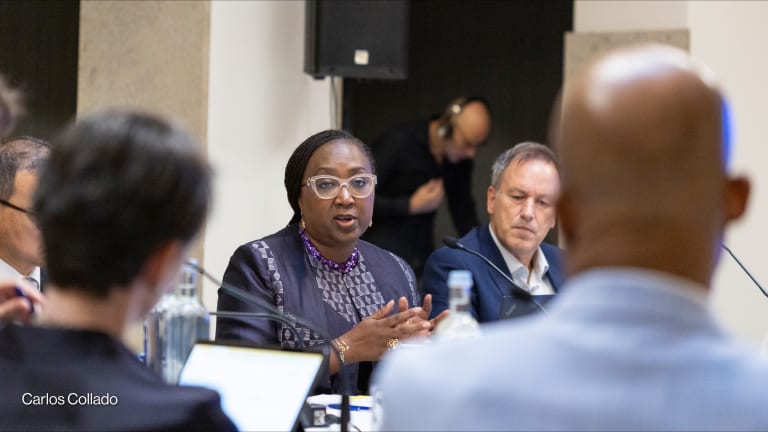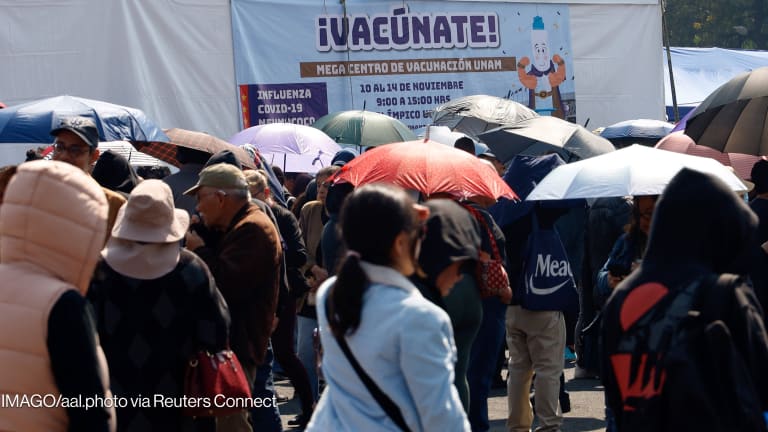'The vision is to transform global health security'
Dr. Raj Panjabi has joined the White House National Security Council at a critical moment for the Biden administration's global response to COVID-19 and pandemic preparedness. Devex speaks to Panjabi about the administration's evolving strategy.
Dr. Raj Panjabi is the latest global health leader to take charge of a White House National Security Council position that was eliminated by former U.S. President Donald Trump and then reinstated by President Joe Biden. Panjabi moved to the White House from the U.S. Agency for International Development, where he was the U.S. global malaria coordinator, overseeing the President’s Malaria Initiative. His appointment comes at a pivotal moment for the government’s global response to COVID-19 — and its longer-term approach to pandemic preparedness and global health security. USAID and other agencies are in the midst of a shift from pushing COVID-19 vaccinations out the door to working with country governments and other partners to overcome the barriers preventing people from getting vaccinated. That means taking a broader view of the health system components that enable countries to respond to disease outbreaks and other health threats. “I'm a primary care doctor. I would be the first to say, ‘Let's invest very broadly,’” Panjabi told Devex. “In many cases, the most effective — but also the most efficient — way to spend that dollar is to leverage the existing clinics, health workers, labs, surveillance systems that are there,” he said. Panjabi spoke to Devex about how the Biden administration’s global health security strategy is evolving, what that means for integrated global health financing, and what needs to change to ensure the world is better prepared next time. This conversation has been edited for length and clarity. How is the Biden administration’s global response to COVID-19 and pandemic preparedness in general shifting in year two? And is the role you’ve inherited on the National Security Council also evolving? The first year focused heavily on ensuring that vaccinations were supplied. Under President Biden's leadership, we've donated 1.2 billion vaccine doses to the world, with more than 500 million doses already delivered to 113 countries. The challenge now is turning these vaccines into vaccinations, and it's part of the reason the president has asked Congress for supplemental financing for COVID-19 that includes support for the global response. That will involve helping expand the number of vaccinators. It will involve expanding vaccination sites: bringing vaccinations to people rather than waiting for people to come to vaccination sites; mobile vans; ensuring that the refrigerators are out there [to keep doses cold]. I was very involved in the COVID response here in the United States, and we know similar strategies were needed to get vaccination rates up in marginalized communities in this country. We now have new countermeasures in response to COVID that we didn't have last year. We didn't have the antiviral therapies we now have, especially oral antiviral therapies. There is work that needs to be done … to ensure global access to oral treatments, and with that, of course, the capacity to do testing and treatment for patients who fall sick. Some of the therapies have effectiveness as high as 90% in terms of reducing hospitalization and severe disease. The large, “true north” strategic shift is to understand that our vaccine targets in year one — the 70% global target [for fully vaccinating populations against COVID-19] — is still a goal of many countries, and we stand ready to support that. … We also want to work with those countries to reduce the hospitalization and the death rate from COVID-19, and we've come to learn that vaccinations are most effective in saving lives and reducing severe disease. [This requires] ensuring that for high-risk groups, we understand how well vaccinated those populations are. We often hear about the “cycle of panic and neglect” in global health security and outbreak response. Do you find it discouraging that even in the middle of a pandemic, it's a struggle to get adequate funding? Congressional inaction will hamper our response here [in the U.S.] and globally. … Understanding that the faster we act, the more impactful we'll be — and the less money and less lives it will cost us in the future — is still a lesson that is as true today as it was a year ago or two years ago, when the pandemic first started emerging around the world. One of the things that every leader is going to get asked — that the president is getting asked — is ... what can we do to stop future pandemics? And the answer to that is to increase and sustain our investments across the United States government to better prevent, detect, and respond to pandemics and ensure that the world is safe and secure from other biological threats. One of the things that we're excited about is work that's being done by the interagency — about 16 departments and agencies, from USAID to the U.S. Department of Agriculture to [the Department of] Health & Human Services — to ensure that we have [an updated] national biodefense strategy — that is essentially our pandemic preparedness plan for the country — that is more robust and has greater investments than ever before. “I'm a primary care doctor. I would be the first to say, ‘Let's invest very broadly.’” --— Dr. Raj Panjabi, senior director for global health security and biodefense, U.S. National Security Council Can you articulate what the Biden administration thinks needs to change within the U.S. government, or in coordination with multilateral organizations, to be better prepared for and better able to respond to global disease outbreaks? The vision is to transform global health security and pandemic preparedness. Obviously we have an active challenge of addressing and responding to new COVID variants, but also future biological threats — the new viruses to come. A biological threat anywhere can turn into a health emergency everywhere, and we believe the most effective way to respond to those biological threats or future outbreaks … is to respond to them at their source. So one of the things that you will see us continue to do is to ensure that there is robust financing to make these transformative investments in pandemic and biological threat preparedness globally. One of the things that you've already heard commitments around is … a new financial intermediary fund at the World Bank focused on global health security and pandemic preparedness. … The idea is to provide a more structured platform to account for and measure international gaps and gains in pandemic preparedness. There are still community health workers who lack adequate personal protective equipment when they're going door-to-door to help screen or test people, or to promote the use of masks in their community. We need to be better prepared the next time. How does that preparedness view integrate with the global health system that currently exists inside the U.S. government — which was largely built around vertical initiatives targeting specific infectious diseases? If this is new financing, it has to be laser-focused on trying to serve an objective. You can't ask for new financing, whether it's in the United States or around the world, without knowing what impact you're trying to create. Impact here would mean detecting outbreaks within seven days, ensuring that they are reported within a day, and then ensuring that within seven days or less, control measures are established. Speed is one of the most critical attributes in a response. So what are the preparedness functions that need to be in place? You've got to have door-to-door health workers looking for symptoms. You've got to have clinics, health workers with the right capability. If we have a new respiratory pathogen, we have to have the capability to do chest X-rays and rapid tests and treatments, as well as ensuring that those patients get tested and that laboratory and surveillance capabilities are in place. And of course, we also have to get better, faster, and more equitable in the way we develop countermeasures. We have an excess of supply of vaccines in many countries — not all — relative to the current ability to "absorb" those vaccines. Now, I don't like the word "absorb"; I'm just quoting that usage, because the truth is that countries don't have an absorption issue. Their health systems have needed more health workers. They have needed more refrigerators. I've worked in rural rainforests my entire career where you can't even get a solar panel on a clinic to keep a refrigerator functioning. What we have to recognize is if we want better pandemic preparedness and response, we've got to build those systems and make sure new financing is integrated. That fridge that we might put in for ultra cold chain capacity for a COVID vaccine today would best serve a future pandemic of flu or the next coronavirus if that same clinic in that rainforest used that fridge daily for ensuring that kids at risk of polio or measles get vaccinated — or malaria, with the new vaccine that's out — which means that you've got to keep a solar panel on the roof of that clinic running, and the clinic has to be staffed, and a supply chain needs to be built. I just don't see how else you could end the epidemics of HIV, TB [tuberculosis], or malaria — as we've been focused on in the United States for many years globally — or the next epidemic or pandemic without building those key high-impact components of a health care system. Update, March 30, 2022: This article has been updated to reflect that the U.S. national biodefense strategy is being updated.
Dr. Raj Panjabi is the latest global health leader to take charge of a White House National Security Council position that was eliminated by former U.S. President Donald Trump and then reinstated by President Joe Biden.
Panjabi moved to the White House from the U.S. Agency for International Development, where he was the U.S. global malaria coordinator, overseeing the President’s Malaria Initiative. His appointment comes at a pivotal moment for the government’s global response to COVID-19 — and its longer-term approach to pandemic preparedness and global health security.
USAID and other agencies are in the midst of a shift from pushing COVID-19 vaccinations out the door to working with country governments and other partners to overcome the barriers preventing people from getting vaccinated. That means taking a broader view of the health system components that enable countries to respond to disease outbreaks and other health threats.
This story is forDevex Promembers
Unlock this story now with a 15-day free trial of Devex Pro.
With a Devex Pro subscription you'll get access to deeper analysis and exclusive insights from our reporters and analysts.
Start my free trialRequest a group subscription Printing articles to share with others is a breach of our terms and conditions and copyright policy. Please use the sharing options on the left side of the article. Devex Pro members may share up to 10 articles per month using the Pro share tool ( ).
Michael Igoe is a Senior Reporter with Devex, based in Washington, D.C. He covers U.S. foreign aid, global health, climate change, and development finance. Prior to joining Devex, Michael researched water management and climate change adaptation in post-Soviet Central Asia, where he also wrote for EurasiaNet. Michael earned his bachelor's degree from Bowdoin College, where he majored in Russian, and his master’s degree from the University of Montana, where he studied international conservation and development.








